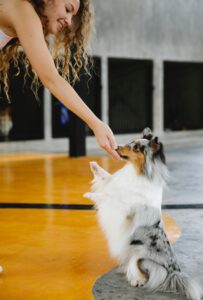Adopting a Rescue Dog: What to Expect and How to Prepare
Adopting a rescue dog is a rewarding experience, as you not only provide a loving home for a dog in need but also gain a loyal companion. This guide will help you understand what to expect during the adoption process and how to create a welcoming environment for your new family member.
The Adoption Process
When adopting a rescue dog, you’ll typically go through an application process that involves filling out forms, providing references, and often going through a home visit. This is to ensure that the dog is placed in a suitable and loving home. Be prepared to answer questions about your lifestyle, living situation, and your ability to care for a dog.
Once your application is approved, you’ll have the chance to meet the dog and spend some time together. If you both feel a connection, the adoption process will move forward. Before bringing the dog home, you’ll likely need to pay an adoption fee, which helps cover the cost of the dog’s care while in the shelter.
Creating a Welcoming Environment
To make your new dog feel at home, follow these steps:
Puppy Proofing Your Home
To ensure your new dog’s safety, it’s essential to puppy-proof your home. Here’s a table with some examples of how to do this:
| Number | Item to Puppy Proof | Room in the House | How to Puppy Proof |
| 1 | Electrical cords | All rooms | Use cord covers or conceal cords behind furniture. |
| 2 | Trash cans | Kitchen, bathroom | Use lidded trash cans or place them in a locked cabinet. |
| 3 | Household chemicals | All rooms | Store chemicals in a locked cabinet or on high shelves. |
| 4 | Medications | Bathroom, bedroom | Keep medications in a locked cabinet or out of reach. |
| 5 | Sharp objects | Kitchen | Store knives and other sharp items in locked drawers. |
| 6 | Choking hazards | All rooms | Remove small objects that a dog could potentially swallow. |
Providing Comfort and Security
Set up a comfortable sleeping area for your dog, complete with a cozy bed, blankets, and a few toys. For more on creating a comfortable sleeping area, visit Let Sleeping Dogs Lie.
 Establishing a Routine
Establishing a Routine
Establishing a daily routine for your rescue dog is essential in helping them feel secure and comfortable in their new home. Routines provide structure and predictability, which can greatly reduce anxiety and stress for your dog. By creating a consistent schedule for feeding, walking, and playtime, you will help your dog adjust to their new environment more quickly and easily.
Feeding
- Choose the right food: The first step in establishing a routine for feeding is to choose the right food for your dog. Consult with your veterinarian to determine the best diet based on your dog’s age, breed, size, and any specific health needs. You can also refer to The Ultimate Guide to Canine Nutrition for more information on selecting the right food for your dog.
- Create a feeding schedule: Establish a consistent feeding schedule for your dog by providing meals at the same time every day. Most adult dogs should be fed twice a day, while puppies may need more frequent meals. Stick to the schedule as closely as possible to help your dog adjust and reduce any stress or anxiety related to mealtime.
- Monitor portion sizes: Ensure that you are feeding your dog the appropriate amount of food based on their size, age, and activity level. Overfeeding can lead to obesity and health issues, while underfeeding can result in malnourishment. Refer to the feeding guidelines provided by your dog food manufacturer and consult with your veterinarian to determine the proper portion size for your dog.
- Limit treats: While it’s tempting to spoil your new dog with treats, it’s essential to keep them in moderation to avoid weight gain and maintain a balanced diet. Treats should make up no more than 10% of your dog’s daily caloric intake.
Walking
- Choose the right equipment: Before you start walking your dog, ensure you have the right equipment, including a comfortable collar or harness and a sturdy leash. A properly fitted collar or harness ensures your dog’s safety and comfort during walks.
- Establish a walking schedule: Create a consistent schedule for walking your dog, with at least one walk in the morning and one in the evening. Consistency is key, as dogs thrive on routine and predictability. Your dog will soon learn when to expect their walks, which can help reduce anxiety and provide them with a sense of stability.
- Adjust walk duration and intensity: The length and intensity of your dog’s walks will depend on their breed, age, size, and overall health. Consult with your veterinarian to determine the appropriate amount of exercise for your dog. Remember to gradually increase the duration and intensity of walks, especially if your dog is new to exercise or recovering from an illness or injury.
- Socialization: Use walks as an opportunity to socialize your dog with other dogs and people. Positive interactions with other dogs and humans can help build your dog’s confidence and prevent behavioral issues. Always monitor your dog’s body language and interactions to ensure their safety and comfort.

Playtime
- Choose appropriate toys: Select toys that are appropriate for your dog’s size, breed, and play style. Be sure to provide a variety of toys, including chew toys, puzzle toys, and fetch toys, to keep your dog engaged and entertained.
- Schedule play sessions: Schedule regular play sessions with your dog to provide them with mental and physical stimulation. Playtime not only strengthens the bond between you and your dog but also helps to reduce boredom, which can lead to destructive behaviors.
Rotate toys
To maintain your dog’s interest in their toys, rotate them regularly by putting some away and reintroducing them later. This can help keep your dog engaged and prevent them from becoming bored with their toys.
- Incorporate training: Use playtime as an opportunity to reinforce training and practice commands. Incorporating training into play sessions can make learning fun for your dog and help them retain new behaviors more effectively.
- Monitor play: Always supervise your dog during playtime to ensure their safety and prevent any potential injuries. Be mindful of your dog’s body language and energy levels, and stop play if they show signs of stress, fear, or aggression.
Additional Routines
- Bedtime: Establish a consistent bedtime routine for your dog. This may include a final potty break, a calming activity such as a gentle massage or brushing, and guiding your dog to their sleeping area. Creating a predictable bedtime routine can help your dog wind down and signal that it’s time for sleep.
- Grooming: Regular grooming is essential for maintaining your dog’s overall health and wellbeing. Establish a grooming routine that includes brushing, bathing, nail trimming, and dental care. Consistency in grooming can help your dog become more comfortable with the process and make it a positive experience for both of you.
- Training: Consistent training is crucial for reinforcing good behaviors and addressing any unwanted habits. Set aside time each day to work on training and practice commands with your dog. Regular training sessions not only strengthen your bond but also provide your dog with mental stimulation and a sense of accomplishment.

By establishing a consistent daily routine for feeding, walking, and playtime, you help create a stable and predictable environment for your rescue dog. This can significantly reduce anxiety, promote good behaviors, and foster a strong bond between you and your new companion. As you continue to learn more about your dog’s specific needs and preferences, you can adjust and fine-tune their routine to ensure they enjoy a happy, healthy, and fulfilling life in their new home. Remember to consult with your veterinarian and refer to resources like The Ultimate Guide to Canine Nutrition and K9 Sprinter Health & Wellness category for additional information on dog care and wellbeing.
Introducing Your Dog to Family Members and Other Pets
Adopting a rescue dog is an exciting time for your family, but it’s essential to remember that it can be a stressful period for your new pet. They may be experiencing new surroundings, people, and possibly other animals for the first time. Introduce your new dog to all family members and other pets slowly and calmly, allowing them to become comfortable with each new person or animal. Here are some tips for making these introductions go as smoothly as possible.
- Take it slow: When introducing your new dog to family members, start with one person at a time. Overwhelming your pet with too many people can cause anxiety and fear. Allow your dog to approach each person at their own pace and avoid forcing interactions. Offer treats and use positive reinforcement to make the experience enjoyable for your new pet.
- Use a calm, gentle tone: Speak to your new dog in a calm, gentle tone when introducing them to family members. Avoid loud noises or sudden movements, as these can frighten your pet. Encourage family members to speak softly and move slowly to create a relaxed environment.
- Respect your dog’s boundaries: Some dogs may be more timid or fearful than others, especially if they have experienced trauma in their past. It’s crucial to respect your dog’s boundaries and not push them into uncomfortable situations. If your dog shows signs of fear or discomfort, give them space and time to adjust.
- Introducing children: Introducing your new dog to children can be particularly challenging, as young kids may not understand the importance of being gentle and calm. Teach your children how to interact with the dog safely and encourage them to approach the dog slowly, allowing the dog to sniff their hand before petting. Supervise interactions between your dog and children, especially in the beginning, to ensure everyone’s safety.
- Introducing other pets: When introducing your new dog to other pets, it’s essential to do so gradually and in a controlled environment. Start by introducing your dog to the scent of the other pets by swapping bedding or toys before any face-to-face meetings. For the initial introduction, choose a neutral location, such as a park or a friend’s backyard, and have both animals on leashes. Allow the pets to observe each other from a distance before gradually allowing them to approach each other. Reward positive interactions with treats and praise, but be prepared to intervene if signs of aggression or fear arise.
- Monitor interactions: Once your new dog has met all family members and other pets, continue to monitor their interactions. Look for signs of stress or anxiety in your dog, such as excessive panting, growling, or cowering, and address any issues that may arise. It’s essential to be patient, as it can take time for your new pet to feel comfortable and safe in their new home.
In conclusion, introducing your new dog to family members and other pets requires patience, understanding, and a gentle approach. By taking it slow, using a calm tone, respecting your dog’s boundaries, and monitoring interactions, you can create a welcoming environment that helps your new furry family member feel at ease. With time and persistence, your rescue dog will form strong bonds with their new family and live a happy, well-adjusted life.
Paws and Claws: A Rescue Organization You Can Trust
Paws and Claws is a dedicated rescue organization that focuses on saving dogs from high-kill shelters and finding them loving forever homes. They work tirelessly to rescue, rehabilitate, and rehome dogs of all ages, sizes, and breeds.
One of the key aspects of Paws and Claws is their commitment to education and community outreach. They believe in the importance of educating the public about responsible pet ownership, the benefits of spaying and neutering, and the critical need for rescue organizations. They also offer various resources and support to adopters, ensuring a smooth transition for both the dog and their new family.
Paws and Claws provides medical care, including vaccinations and spay/neuter procedures, for all dogs in their care. They also address any behavioral issues through training and socialization, helping dogs become well-adjusted and ready for their new homes.
When adopting a dog from Paws and Claws, you can expect a thorough adoption process, including an application, reference checks, and a home visit. This is to ensure that each dog finds the best possible match for their needs and personality. Paws and Claws is committed to finding the right fit for both the dog and the adopter, ensuring a successful and lasting relationship.
Once you’ve adopted a dog from Paws and Claws, they offer ongoing support and resources to help you navigate any challenges that may arise. They are dedicated to the long-term well-being of their dogs and are always available to answer questions and provide guidance.
In addition to their rescue and adoption efforts, Paws and Claws is also involved in various community events, fundraisers, and educational programs. They are always looking for volunteers and donations to support their mission and help more dogs find their forever homes.
Embracing Fear-Free Training Techniques
Fear-free techniques are training methods that prioritize the comfort, safety, and emotional well-being of your dog throughout the learning process. The primary goal of these techniques is to create a positive and low-stress environment where your dog can learn new behaviors and skills without experiencing fear or anxiety. By utilizing positive reinforcement, clear communication, and gentle guidance, fear-free techniques help to build trust and strengthen the bond between you and your dog.
Positive reinforcement is a fundamental component of fear-free training, where desired behaviors are rewarded with treats, praise, or toys, while undesired behaviors are ignored or redirected. This approach helps your dog associate positive experiences with performing specific actions, making it more likely that they will repeat those behaviors in the future. Clear communication is also essential in fear-free training, using tools such as clickers or verbal cues to provide your dog with consistent feedback on their actions.
Desensitization and counter-conditioning are examples of fear-free techniques that can be used to help your dog overcome anxiety or fear related to specific stimuli, such as loud noises, new people, or unfamiliar environments. By gradually exposing your dog to the fear-inducing stimulus at a low intensity and pairing it with a positive experience, you can help them build confidence and form new, positive associations with previously fearful situations.
Overall, fear-free techniques promote a training environment where your dog can learn and grow without experiencing stress or discomfort. By focusing on their emotional well-being and providing consistent, positive reinforcement, you can create a strong foundation for a happy, well-adjusted, and confident canine companion.
5 Fear-Free Training Exercises
- Target training: This exercise involves teaching your dog to touch a specific object, such as a target stick or your hand, with their nose. Start by holding the target close to your dog’s nose and reward them with a treat when they make contact. Gradually increase the distance between the target and your dog’s nose, ensuring they remain comfortable and confident throughout the process. Target training can help build trust and focus while maintaining a low-stress environment for your dog.
- Capturing calmness: This exercise encourages calm behavior in your dog by rewarding them when they exhibit relaxed behaviors, such as lying down or sitting quietly. Keep treats handy and calmly praise and reward your dog whenever they display the desired behavior. This positive reinforcement helps your dog associate calmness with positive outcomes, reducing fear and anxiety during training sessions.
- Desensitization and counter-conditioning: This technique involves gradually exposing your dog to a fear-inducing stimulus (such as loud noises or new people) at a low intensity, while simultaneously pairing the stimulus with a positive experience (like treats or praise). As your dog becomes more comfortable with the stimulus, gradually increase its intensity. This exercise helps your dog learn to associate previously fearful situations with positive experiences, reducing fear and anxiety.
- Clicker training: Using a clicker can be an effective way to communicate with your dog during training sessions. The clicker serves as a “bridge” between the desired behavior and the reward, allowing your dog to understand which action is being rewarded. Begin by “charging” the clicker, which means clicking and treating your dog repeatedly until they associate the sound with a reward. Once the association is established, use the clicker to mark the precise moment your dog performs the desired behavior, followed by a treat. This method helps maintain a low-stress environment by providing clear communication and consistent reinforcement.
- Lure-reward training: In this exercise, use a treat or toy to guide your dog into the desired position or action. For example, to teach your dog to sit, hold the treat close to their nose and slowly move it back and up, causing your dog to naturally move into a sitting position. As soon as your dog sits, reward them with the treat and praise. Lure-reward training is a gentle and effective way to teach new behaviors without causing fear or discomfort.
The Benefits of Choosing a Fear-Free Business
Choosing the services of a fear-free business, such as K9 Sprinter, offers numerous benefits for both you and your dog. The primary advantage is the focus on your dog’s emotional well-being, ensuring that their training, care, and overall experience prioritize their comfort, safety, and happiness.
Fear-free businesses employ techniques that use positive reinforcement, gentle guidance, and clear communication, which help to build trust and strengthen the bond between you and your dog. These methods are particularly beneficial for dogs who may have experienced trauma, anxiety, or fear in the past, as they promote a safe and low-stress environment that fosters confidence and reduces anxiety.
In addition, fear-free businesses typically employ professionals who are knowledgeable about dog behavior, body language, and the most up-to-date training methods. This expertise ensures that your dog receives customized care and training tailored to their unique needs and temperament, leading to more effective and enjoyable learning experiences.
By opting for a fear-free business like K9 Sprinter, you are investing in your dog’s overall well-being and happiness. Not only does this create a more enjoyable experience for your pet, but it also contributes to their long-term success in learning new behaviors, overcoming challenges, and integrating smoothly into your family and home. The focus on emotional well-being and positive reinforcement ultimately leads to a more fulfilling and rewarding relationship with your canine companion.
Adopting a rescue dog is a life-changing decision that not only benefits the dog but also brings joy and companionship to your life. By preparing your home, establishing a routine, and understanding the adoption process, you can create a welcoming environment for your new family member. Organizations like Paws and Claws are invaluable resources for adopters, providing support and guidance throughout the adoption journey.
For further information on dog care, visit the K9 Sprinter Health & Wellness category and learn about topics like senior dog care and obesity prevention. With the right knowledge and support, you can ensure a happy and healthy life for your rescue dog.
Checklist Before Bringing a New Dog Home from the Shelter
- Dog-proof your home: Secure electrical cords, store chemicals and medications safely, and remove any potential hazards. Make sure trash cans have lids or are stored in locked cabinets.
- Purchase necessary supplies: Acquire a collar, leash, dog bed, crate (if needed), food and water bowls, grooming tools, dog food, and a variety of toys.
- Choose a veterinarian: Research local veterinarians and choose one that suits your needs and preferences. Schedule an initial checkup appointment.
- Create a designated space: Set up a comfortable and quiet area for your dog to sleep and relax. This should include a dog bed, blankets, and a few toys.
- Plan a daily routine: Establish a schedule for feeding, walking, playtime, and training. This will help your dog adjust to their new environment more easily.
- Prepare family members and other pets: Talk to your family about the responsibilities of owning a dog and how to properly interact with them. If you have other pets, prepare them for the new arrival.
- Learn about your dog’s breed and specific needs: Research your dog’s breed to understand their unique characteristics, exercise requirements, and potential health issues.
Checklist for New Dog Parents After Their Dog is Home from the Shelter
- Gradually introduce your dog to their new environment: Give your dog time to explore and adjust to their new home. Allow them to approach new spaces, people, and other pets at their own pace.
- Schedule a veterinary appointment: Take your dog to the veterinarian for a general health checkup and to address any medical concerns or vaccinations.
- Begin a feeding routine: Start your dog on a consistent feeding schedule based on their age, breed, and specific nutritional needs.
- Start a walking and exercise routine: Establish a consistent schedule for walking and exercise, taking into account your dog’s breed, age, and fitness level.
- Introduce training and socialization: Begin working on basic commands and training, and gradually introduce your dog to new people, animals, and situations.
- Monitor your dog’s behavior and health: Keep an eye on your dog’s behavior, eating habits, and overall health. If you notice any changes or concerns, contact your veterinarian.
- Establish a grooming routine: Begin a regular grooming routine that includes brushing, bathing, nail trimming, and dental care.
- Join a dog training class or group: Consider enrolling in a dog training class or joining a local dog group to further your dog’s socialization and training progress.
- Provide ongoing love, support, and patience: Be patient with your dog as they adjust to their new home, and provide consistent love, support, and understanding.
- Stay informed and educate yourself: Continuously educate yourself on dog care, training, and health by consulting reputable resources and staying up-to-date on new information.
- Book a Trial Run if you adopted from Paws and Claws Rochester: If you adopted your dog from Paws and Claws Rochester, take advantage of their support and resources by booking a Trial Run. This will help ensure a smooth transition for both you and your dog, and provide you with valuable guidance and assistance during the initial stages of your dog’s new life at home.




